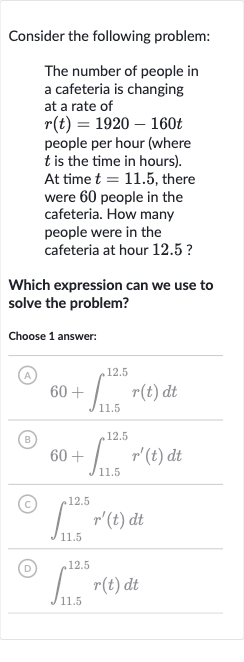AI tutor
Welcome to Bytelearn!
Let’s check out your problem:

Consider the following problem:The number of people in a cafeteria is changing at a rate of people per hour (where is the time in hours). At time , there were people in the cafeteria. How many people were in the cafeteria at hour . ?Which expression can we use to solve the problem?Choose answer:(A) (B) (C) (D)
Full solution
Q. Consider the following problem:The number of people in a cafeteria is changing at a rate of people per hour (where is the time in hours). At time , there were people in the cafeteria. How many people were in the cafeteria at hour . ?Which expression can we use to solve the problem?Choose answer:(A) (B) (C) (D)
- Understand rate function: To solve this problem, we need to understand that the rate of change of the number of people in the cafeteria is given by the function . To find the total change in the number of people from hour to hour , we need to integrate the rate function over this time interval. The initial number of people at time is given as , so we need to add this initial value to the integral of the rate function to find the total number of people at hour .
- Calculate total change: We will use the expression (A) to calculate the number of people in the cafeteria at hour . This is because we are given the initial number of people at , which is , and we need to add the change in the number of people from to , which is given by the integral of the rate function over that interval.
- Integrate rate function: Now we need to calculate the integral of from to . The function is given by . We will integrate this function with respect to over the interval . from to .
- Evaluate antiderivative: We will now evaluate the antiderivative at the upper and lower limits of the integral and subtract the lower limit evaluation from the upper limit evaluation.At : .At : .
- Re-evaluate at : We will re-evaluate the antiderivative at correctly.At : .This is incorrect, let's try again..
- Find change in people: Now we subtract the value of the antiderivative at from the value at to find the change in the number of people from hour to hour .Change in number of people = people.
- Calculate total at .: Finally, we add the initial number of people at to the change in the number of people to find the total number of people at hour . Total number of people at hour people.
